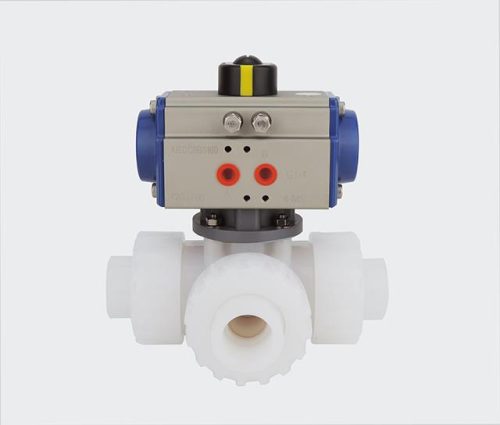PVDF ball valves are a standout choice among plastic valves, offering exceptional chemical resistance and durability in demanding applications. This blog post explores their ability to withstand strong acids, bases, halogens, and organic solvents. Making them ideal for industries like chemical processing and pharmaceuticals. Compared to PVC ball valves and CPVC ball valves, PVDF valves excel under high temperatures and aggressive chemical conditions while ensuring reliability and longevity. Key features include lightweight construction, high-pressure compatibility, and non-leaching properties for purity-critical operations. For those seeking a plastic ball valve that balances performance and longevity. PVDF is a top contender with clear advantages over other options.
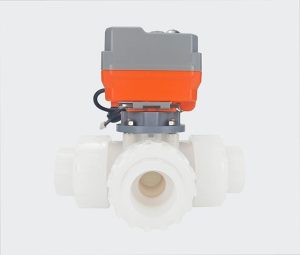
Introduction
Plastic valves are an essential component in industrial applications due to their versatility, durability, and cost-effectiveness. Constructed from materials such as PVC, CPVC, and PVDF, these valves offer a range of benefits that make them indispensable in demanding operational settings. Their exceptional chemical resistance enables them to handle corrosive substances. Including strong acids, bases, and solvents, making them ideal for industries such as chemical processing, water treatment, and pharmaceuticals.
Additionally, the lightweight nature of plastic valves simplifies installation and reduces overall system weight without compromising strength or reliability. PVC and CPVC valves are commonly used in low- to medium-temperature environments, while PVDF valves, renowned for their superior resistance to aggressive chemicals and high temperatures, are favored in high-performance applications. By ensuring efficiency, reducing maintenance needs, and maintaining critical flow control, plastic valves play a pivotal role in enhancing productivity while minimizing operational risks across diverse industrial sectors.
PVDF (Polyvinylidene Fluoride) ball valves are engineered to excel in environments that demand exceptional chemical resistance and operational reliability. These valves are uniquely capable of withstanding harsh substances. Including strong acids, bases, halogens, and various organic solvents, making them an optimal choice for industries where exposure to aggressive chemicals is a constant concern. Their performance remains unmatched when compared to other materials like PVC and CPVC. Particularly in high-temperature and high-pressure scenarios where standard plastic valves may falter.
PVDF’s resilience to corrosion and wear significantly extends its operational lifespan. Ensuring steady performance even in the most challenging applications. Such as chemical processing, pharmaceuticals, and water treatment. Beyond durability, PVDF ball valves enhance safety by minimizing the risk of leaks or failures, a critical factor in environments handling hazardous substances. Additionally, their long-term cost efficiency, driven by reduced maintenance and replacement needs, establishes PVDF as an invaluable material for industries prioritizing both performance and reliability.
Section 1: Understanding Plastic Valves and Material Composition
Material selection plays a vital role in the manufacturing of plastic valves, directly impacting their performance, longevity, and suitability for specific applications. Different industrial environments demand diverse material properties. And this is where options like PVC, CPVC, and PVDF come into focus. PVC is a widely used choice due to its versatility, cost-effectiveness, and moderate chemical resistance. Making it ideal for general-purpose applications such as water distribution and basic chemical transport. CPVC, on the other hand, offers enhanced temperature resistance while maintaining excellent durability and chemical compatibility. Making it an excellent choice for industries requiring the handling of hot corrosive fluids. Such as in thermal systems or piping hot water.
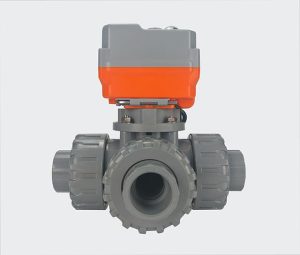
PVDF, with its superior resilience to aggressive chemicals, extreme temperatures, and high pressures, stands out as a premium choice for demanding environments like chemical processing and pharmaceutical manufacturing. Factors such as resistance to corrosion, thermal stability, and pressure endurance must be carefully considered to ensure safety and efficiency in operation. While a misstep in material selection can lead to frequent repairs or system failures, a well-chosen plastic valve material optimizes performance, reduces downtime, and delivers long-term cost-saving benefits in industrial operations.
Section 2: Chemical Resistance of PVDF Ball Valves
PVDF (Polyvinylidene Fluoride) is renowned for its outstanding chemical resistance. Making it a preferred material in industries dealing with highly aggressive substances. It can withstand strong acids like hydrochloric and sulfuric acid, as well as potent bases such as sodium hydroxide, without degrading or compromising its structural integrity. Additionally, PVDF is highly resistant to halogens, including chlorine and fluorine, and exhibits compatibility with most organic solvents, further broadening its applicability. These unique properties allow PVDF to perform exceptionally well in demanding industrial environments such as chemical processing, pharmaceuticals, and water treatment. Where exposure to corrosive agents is routine. Its ability to maintain performance under prolonged chemical exposure ensures systems remain safe and reliable, reducing the likelihood of leaks or equipment failure.
Furthermore, PVDF’s resilience minimizes maintenance requirements and extends service life, offering long-term cost efficiency. This combination of chemical resistance and durability makes PVDF an unmatched choice for applications requiring maximum reliability and safety in harsh operating conditions.
Section 3: Key Features of PVDF Ball Valves
– Durable and lightweight construction.
One of the most appealing attributes of plastic valves, particularly those made from PVDF, is their durable yet lightweight construction. Which offers significant advantages in industrial applications. The lightweight nature of these valves makes installation far less labor-intensive compared to metal alternatives. Enabling faster setup and reducing the physical strain on piping systems. Despite their reduced weight, PVDF valves exhibit remarkable durability, designed to withstand harsh operating conditions like high pressures, extreme temperatures, and exposure to corrosive chemicals.

This combination of strength and lightweight design enhances operational efficiency across industries such as chemical processing, water treatment, and pharmaceuticals. It minimizes the need for additional structural support, reduces wear on system components, and ensures long-term reliability. These characteristics translate into measurable cost savings through reduced installation time, lower maintenance needs, and extended service life. Making PVDF valves a versatile and efficient choice for a broad range of industrial requirements.
– High temperature tolerance compared to PVC and CPVC ball valves.
PVDF ball valves excel in high-performance applications due to their superior temperature tolerance compared to PVC and CPVC ball valves. While PVC valves are generally restricted to operation in temperatures up to 60°C (140°F) and CPVC can handle slightly higher temperatures around 93°C (200°F), PVDF valves far exceed these limits with the ability to withstand continuous exposure to temperatures as high as 150°C (302°F). This exceptional thermal stability makes PVDF the material of choice for demanding environments involving high-temperature fluid handling or thermal cycling. Such as in chemical processing, pharmaceutical production, and industrial heating systems.
Unlike PVC and CPVC, which can warp or degrade under prolonged exposure to extreme heat, PVDF maintains its mechanical strength and structural integrity under thermal stress. Ensuring consistent performance and reducing the risk of operational failures. This capability not only enhances system safety but also minimizes maintenance interruptions. Offering long-term durability and cost-efficiency. By combining high-temperature resistance with chemical resilience, PVDF valves deliver unparalleled reliability in applications that demand robust and efficient thermal performance.
– Non-leaching properties, ideal for applications requiring purity.
PVDF (Polyvinylidene Fluoride) is highly regarded for its non-leaching properties, making it an ideal material for applications where purity is paramount. Unlike other materials that may release trace chemicals or degrade over time, PVDF exhibits exceptional stability, ensuring that no contaminants compromise the systems it is part of. This quality is particularly critical in sensitive environments such as pharmaceutical production, food and beverage processing, and semiconductor manufacturing. Where even minute contamination can jeopardize product integrity, pose safety risks, or lead to compliance failures.
PVDF’s non-leaching nature guarantees that fluids, chemicals, or gases maintain their purity throughout processing, aligning with the rigorous standards required in these industries. Additionally, it contributes to safer operations by reducing the risk of interactions between the valve material and the medium being transported. Its consistent performance and reliability in maintaining uncontaminated environments firmly establish PVDF as a trusted choice in high-purity applications, offering peace of mind, safety, and long-term operational compliance.
– Compatibility with high-pressure systems.
PVDF (Polyvinylidene Fluoride) ball valves are highly compatible with high-pressure systems due to their exceptional mechanical strength and structural integrity. These attributes allow PVDF valves to endure the intense demands of high-pressure environments without deforming or failing under stress. This makes them indispensable in industries such as chemical processing, water treatment, and oil and gas, where maintaining operational integrity under elevated pressures is critical. PVDF’s inherent resilience ensures that it can consistently perform in conditions where fluctuating or sustained high pressures might compromise other materials.
The material’s robustness not only guarantees safety by minimizing the risk of leaks or system failures but also enhances reliability, as PVDF valves consistently deliver long-term, dependable performance. Their ability to withstand corrosive media and challenging conditions further solidifies their place in high-pressure applications. By combining toughness, chemical resistance, and precision under pressure, PVDF ball valves bring unmatched dependability and efficiency to the most demanding operational environments. Delivering measurable cost savings and peace of mind for industries that rely on seamless performance.
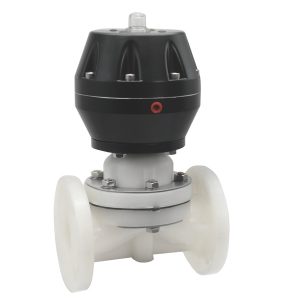
Section 4: Benefits of Using PVDF Ball Valves
PVDF (Polyvinylidene Fluoride) ball valves offer a unique combination of benefits that make them a preferred choice across demanding industries such as chemical processing, pharmaceuticals, water treatment, and food and beverage production. Their outstanding chemical resistance allows them to handle aggressive acids, bases, halogens, and organic solvents without degrading. Ensuring operational reliability even in highly corrosive environments.
With a high-temperature tolerance of up to 150°C (302°F), PVDF valves outperform alternatives like PVC and CPVC. Making them suitable for applications involving elevated temperatures or thermal cycling.
Their lightweight yet durable construction simplifies installation, reduces stress on piping systems, and delivers long-term performance even in challenging conditions. Contributing to overall efficiency.
Additionally, the non-leaching nature of PVDF prevents contamination. Ensuring product purity and compliance with stringent purity standards, a critical factor in sensitive industries like pharmaceutical production and food processing.
Finally, their exceptional compatibility with high-pressure systems further solidifies their reliability, providing safety and consistent performance under elevated pressures. Combined, these features make PVDF ball valves a powerful solution for enhancing safety, operational efficiency, and cost savings while ensuring uninterrupted, high-quality performance in a wide range of industrial applications.
FAQs
What industries typically use PVDF Manual Ball Valves?
PVDF Manual Ball Valves are widely used across industries that handle aggressive chemicals, such as:
Chemical processing plants
Water treatment facilities
Pharma and biotech industries
Mining and metallurgy
Food and beverage production (where high chemical resistance is required)
What are the primary maintenance requirements for PVDF Ball Valves?
To maintain optimal performance, routine checks should include:
Inspecting for wear or damage on the ball, seat, and seals.
Ensuring the valve handle operates smoothly.
Checking for leaks around connection points.
If any components show significant wear or degradation, replace them according to the manufacturer’s recommendations.
What certifications do PVDF Ball Valves comply with?
PVDF Ball Valves often meet industry-specific certifications such as ISO, FDA, NSF, or RoHS compliance, depending on the manufacturer. Check with your supplier for detailed certification documentation for traceability and quality verification.
Where can I purchase PVDF Manual Ball Valves?
You can source PVDF Manual Ball Valves directly through certified valve distributors or manufacturers with a strong reputation for quality control and global reach. Ensure your supplier meets industry standards and provides the necessary technical support for your application needs.For further technical assistance or to request a quote, feel free to contact us. We’re here to ensure your operations run smoothly and safely!
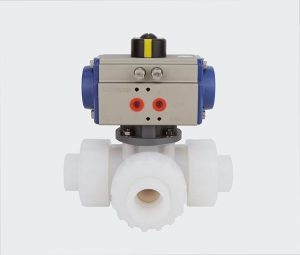
Conclusion
PVDF ball valves stand out as a transformative solution in industries that demand reliable and high-performing components. Their exceptional chemical resistance enables them to handle corrosive substances like acids, bases, and solvents with uncompromised integrity. Ensuring operational confidence even in aggressive environments. Complementing this is their high-temperature tolerance. Which surpasses materials like PVC and CPVC, making them ideal for applications involving heat-intensive processes. The non-leaching properties of PVDF further elevate its value by preventing contamination and ensuring purity in sensitive sectors such as pharmaceuticals and food production.
Additionally, PVDF ball valves excel in handling the challenges posed by high-pressure systems. Maintaining safety and operational reliability in demanding conditions. These attributes, combined with their lightweight yet durable construction, make PVDF ball valves a versatile and essential asset across industries like chemical processing, water treatment, and beyond. Ultimately, investing in PVDF ball valves delivers more than just immediate performance; it fosters long-term safety, efficiency, and operational success. Empowering industries to meet their goals with confidence and precision.

